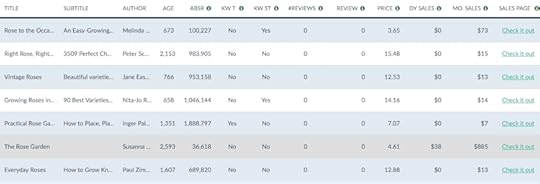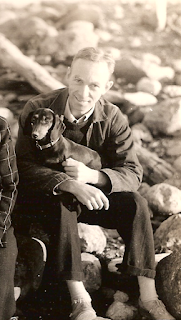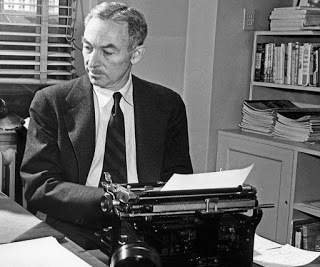Kenneth Atchity's Blog, page 106
December 10, 2018
Ken Atchity on The Strange Kamelion Show at L.A. Talkradio
Ken talks about writing, storytelling and the business of Show Business
Check out more videos at http://www.latalkradio.com
Check out more videos at http://www.latalkradio.com

Published on December 10, 2018 00:00
December 8, 2018
Hanna Flint Exclusive 'The Meg' director shares the secrets of making a killer shark movie
The shark movie has become a staple horror subgenre ever since audiences heard those two notes of John Williams’ daunting Jaws score in 1975.Forty-plus years later, there have been many additions to the B movie tradition, some good (Deep Blue Sea), some bad (Shark Swarm), and some inexplicable (Sharknado), but in 2018 The Meg proved that they can still be a box office hit.The Jason Statham-led shark movie – centred on a mammoth, 70-foot sea creature believed to have been extinct for millions of years – made a staggering £415 million at the international box office making it one of Warner Bros’ most profitable original films of the year.

Audiences have loved shark movies ever since Jaws hit screens in 1975.More
So what makes a shark movie a box office hit? The Meg director Jon Turteltaub gives us the lowdown in his own words… Spoilers ahead.Know the genre

The fin shot is a must for all shark moviesMore
Jon Turteltaub: Like every movie, you have to first understand the genre and what people expect. Then you focus on a good story with good characters. Sometimes you succeed, and sometimes you don’t. You don’t run away from the cliches, you lean into them. I think audiences expect them and like them.With a shark movie, you better see that fin, you better see under the water legs dangling – we love all that stuff and we want to see people dying in really cool ways. That’s what you expect and why you’re going to these movies.Suspense is key

The Meg movieMore
First of all, you want to set deaths up so the audience is not sure if it’s going to happen or not. You don’t necessarily want these to come out of nowhere. The start of these movies is the suspense so the person in the water instantly gives you that sense of “oh no.”The worry about what’s going to happen is actually more interesting and enjoyable for an audience than the death itself. Unless there are two people in the middle of getting married and they love each other and it eats one of them. There’s not that much emotion attached unless it’s one of your major lead characters otherwise you just like watching how they’re going to die but mostly are they going to die? What’s going to happen, what are the choices they make?I really like the death of Dr Heller [in The Meg] because he chooses to die to save Jaxx. The shot of him dying, for me, it’s the most realistic shark shot in the movie because it’s more of how we see sharks rather than how movies see sharks.The kill list

The Meg movieMore
We really pondered this and that really starts with the writers. Have we killed too many people? Have we killed enough people? But a movie like this you are really paying attention to entertainment value. Nobody thought we were going to win a Nobel Prize when we made this movie, our job is to put on a really fun show so you’ve got to figure out not just how many people die, but who too.What’s the price, what’s the cost? The more you love a character the more often it is for them to die but there is a point at which, when that character dies, the audience hates you. In our case, it’s a dog! A lot of people were telling me, “what was this dog doing in the movie, we have all these people to kill?” and all I could think of was people always care more about a dog than a person.

The audience is always on the dog’s sideMore
If there is a dog trapped in a building and you get him out everyone starts crying. If there is a person trapped in a building and you get him out the audience is like” oh cool, glad he’s safe.”Making the shark

They didn’t want it to look like a Great White SharkMore
You have no idea what a complicated process that is because it’s more than having good ideas for the shark but finding those who can realise them. Getting everyone to agree on those ideas is hard too. Everyone has their own point of view, starting with the writers of the novel, to the producers who bought the novel, to the studio who is paying for the movie, then to me who just wants to do what I want to do.That debate of “gigantic great white shark versus creating our own” went on for a long time and I’m glad I got the shark I wanted because I didn’t want the great white, that seemed very low budget for me. It looks like you took a regular great white shark and just made it bigger in the cheapest way possible rather than figuring out what a shark would have looked like millions of years ago, how it would have survived in the ocean and all that sort of stuff.Balancing the visual effects

The visual effects had to make the shark look as real as possibleMore
I feel, as a director, you have to make a decision and decide if you want to scare the audience because it’s real or do something that is really cool. I tend towards real; I want things to feel like real life rather than “look how cool this shot is how the camera can jump off the boat and go through the shark’s mouth and come out the gills” and all that stuff.With visual effects, you can do that, and there are directors who are amazing at doing all that, but for me, I tend to get pulled out of a movie when I can see the director’s hand showing me how cool they are. So I try to create images that feel more real because when you do that it makes the shark look more real and one of the things we talked about was to never let the shark do something that the shark wouldn’t do.Levity is a must

Rainn Wilson brought a lot of comic reliefMore
That was super important to me. Our approach was very tricky because we tried to thread the needle with the notion that the characters in the movie have seen shark movies in their lives. Let’s not pretend they don’t know the cliches or have seen movies like this so you can lean in a little bit to the humour.Let the characters be funny in these extreme situations. I had people saying “do you want it real or do you want it funny?” I don’t know the difference. That’s part of life.More than a hero

Jason Statham makes you feel safe, says TurteltaubMore
We knew we needed the guy who you could believe was a badass hero and could save the day. Jason [Statham] for me took care of the first part, which is much harder to find than you think, but we wanted a person who when you walk in a room you feel safer. You feel like everything is going to be OK and Jason brings that too.He also brings the counterpoint of a sense of humour. He had done a bit of comedy in his movie but he’s never, with the exception of Spy, he’s never been asked to do too much and I think that’s a mistake. You want to believe these super macho guys have another side to them.Sequel?

The Meg is out on digital download nowMore
Sequels usually suck and try to outdo the first one where there’s a bigger shark, ninety sharks, or a poisonous shark and that’s not what audiences want to see. They want to see a really good story that they couldn’t think of themselves.But now that I’ve said it, poisonous sharks sound really cool.The Meg is available on Digital Download now and on DVD and Blu-Ray from December 10.Read more

Audiences have loved shark movies ever since Jaws hit screens in 1975.More
So what makes a shark movie a box office hit? The Meg director Jon Turteltaub gives us the lowdown in his own words… Spoilers ahead.Know the genre

The fin shot is a must for all shark moviesMore
Jon Turteltaub: Like every movie, you have to first understand the genre and what people expect. Then you focus on a good story with good characters. Sometimes you succeed, and sometimes you don’t. You don’t run away from the cliches, you lean into them. I think audiences expect them and like them.With a shark movie, you better see that fin, you better see under the water legs dangling – we love all that stuff and we want to see people dying in really cool ways. That’s what you expect and why you’re going to these movies.Suspense is key

The Meg movieMore
First of all, you want to set deaths up so the audience is not sure if it’s going to happen or not. You don’t necessarily want these to come out of nowhere. The start of these movies is the suspense so the person in the water instantly gives you that sense of “oh no.”The worry about what’s going to happen is actually more interesting and enjoyable for an audience than the death itself. Unless there are two people in the middle of getting married and they love each other and it eats one of them. There’s not that much emotion attached unless it’s one of your major lead characters otherwise you just like watching how they’re going to die but mostly are they going to die? What’s going to happen, what are the choices they make?I really like the death of Dr Heller [in The Meg] because he chooses to die to save Jaxx. The shot of him dying, for me, it’s the most realistic shark shot in the movie because it’s more of how we see sharks rather than how movies see sharks.The kill list

The Meg movieMore
We really pondered this and that really starts with the writers. Have we killed too many people? Have we killed enough people? But a movie like this you are really paying attention to entertainment value. Nobody thought we were going to win a Nobel Prize when we made this movie, our job is to put on a really fun show so you’ve got to figure out not just how many people die, but who too.What’s the price, what’s the cost? The more you love a character the more often it is for them to die but there is a point at which, when that character dies, the audience hates you. In our case, it’s a dog! A lot of people were telling me, “what was this dog doing in the movie, we have all these people to kill?” and all I could think of was people always care more about a dog than a person.

The audience is always on the dog’s sideMore
If there is a dog trapped in a building and you get him out everyone starts crying. If there is a person trapped in a building and you get him out the audience is like” oh cool, glad he’s safe.”Making the shark

They didn’t want it to look like a Great White SharkMore
You have no idea what a complicated process that is because it’s more than having good ideas for the shark but finding those who can realise them. Getting everyone to agree on those ideas is hard too. Everyone has their own point of view, starting with the writers of the novel, to the producers who bought the novel, to the studio who is paying for the movie, then to me who just wants to do what I want to do.That debate of “gigantic great white shark versus creating our own” went on for a long time and I’m glad I got the shark I wanted because I didn’t want the great white, that seemed very low budget for me. It looks like you took a regular great white shark and just made it bigger in the cheapest way possible rather than figuring out what a shark would have looked like millions of years ago, how it would have survived in the ocean and all that sort of stuff.Balancing the visual effects

The visual effects had to make the shark look as real as possibleMore
I feel, as a director, you have to make a decision and decide if you want to scare the audience because it’s real or do something that is really cool. I tend towards real; I want things to feel like real life rather than “look how cool this shot is how the camera can jump off the boat and go through the shark’s mouth and come out the gills” and all that stuff.With visual effects, you can do that, and there are directors who are amazing at doing all that, but for me, I tend to get pulled out of a movie when I can see the director’s hand showing me how cool they are. So I try to create images that feel more real because when you do that it makes the shark look more real and one of the things we talked about was to never let the shark do something that the shark wouldn’t do.Levity is a must

Rainn Wilson brought a lot of comic reliefMore
That was super important to me. Our approach was very tricky because we tried to thread the needle with the notion that the characters in the movie have seen shark movies in their lives. Let’s not pretend they don’t know the cliches or have seen movies like this so you can lean in a little bit to the humour.Let the characters be funny in these extreme situations. I had people saying “do you want it real or do you want it funny?” I don’t know the difference. That’s part of life.More than a hero

Jason Statham makes you feel safe, says TurteltaubMore
We knew we needed the guy who you could believe was a badass hero and could save the day. Jason [Statham] for me took care of the first part, which is much harder to find than you think, but we wanted a person who when you walk in a room you feel safer. You feel like everything is going to be OK and Jason brings that too.He also brings the counterpoint of a sense of humour. He had done a bit of comedy in his movie but he’s never, with the exception of Spy, he’s never been asked to do too much and I think that’s a mistake. You want to believe these super macho guys have another side to them.Sequel?

The Meg is out on digital download nowMore
Sequels usually suck and try to outdo the first one where there’s a bigger shark, ninety sharks, or a poisonous shark and that’s not what audiences want to see. They want to see a really good story that they couldn’t think of themselves.But now that I’ve said it, poisonous sharks sound really cool.The Meg is available on Digital Download now and on DVD and Blu-Ray from December 10.Read more

Published on December 08, 2018 00:00
December 6, 2018
From time to time we run into writers who simply don’t wa...
From time to time we run into writers who simply don’t want to hear notes aimed at making their work more likely to sell and succeed. Their egos keep their eyes from seeing how rare constructive criticism is. They remind me of this great poster we ran across:


Published on December 06, 2018 00:00
December 2, 2018
Self-Publishing: Expectations vs Reality For New Authors

Self-publishing is a great opportunity – if you have a head for business
Are you dreaming of becoming the next bestselling author?
For anyone who writes, it is natural to want your hard work to reap the rewards you believe it deserves.
Self-publishing today gives all authors the chance to publish for (almost) free and to have a book on sale on Amazon and many other online book retailers.
If you use Amazon’s publishing service, Kindle Direct Publishing (KDP), you can publish an ebook, and it will be on sale in around 24 hours.
For a paperback version of a book using print on demand, it takes only a few days.
In the days before self-publishing, the publishing process for a traditional publisher very often took a year or more. It has not changed a great deal for large publishers today.
It is a long road to take to get a book published the traditional way. You need first to find a literary agent to represent you, which is no easy task.
Then if you are lucky enough to find one, it can take months for your agent to secure a publishing contract for you. If you are one of the fortunate authors who manage to get this far, it is then a wait of another year before your book is released.
After that, you cross your fingers and hope your book sells well. Otherwise, the chances of another contract are slim.
However, if you self-publish, you skip all the waiting and jump immediately to crossing your fingers.
So much has changed, but the publishing industry stays the same. It is about hoping that readers will buy your book.
The expectations of publishing a book

I started publishing in 2005 with Createspace. The following four years were marvellous for me for with my print books selling well enough to get a nice check every month.
Then came the ebook.
When I self-published my first ebook in 2011, there were fewer than 800,000 Kindle ebooks on Amazon. Fast forward to today, and it is over 7 million.
Did you know that a new Kindle ebook is now published on average every 3 minutes?
You do not need to be a statistician to calculate that while the number of ebook titles has risen dramatically, the number of book buyers has not increased proportionally.
In simple terms, for a digital book, it is a highly competitive market.
On top of that, Kindle Unlimited has turned all the publishing rules on its head. No longer do you sell a book. You sell page reads. For authors and publishing companies alike, it is a considerable challenge.
Many new authors leap into publishing an ebook on Amazon with the expectation that because their book is for sale, it will sell.
Nothing could be further from the truth. The hard facts are that very few titles sell well, and most struggle to sell more than a handful of copies per year. Mostly to friends and family.
The biggest problem is that many newly published authors do zero market research before a book launch.
If you want to sell anything, you have to know what your market is and how you are going to attract people to buy your product.
Smart indie authors know this and have a clear idea of their genre and what market potential there is for their writing.
For example, there is a massive market for contemporary romance, but only a tiny market for gardening or rose care books. However, a small market segment is less competitive.
Balancing competitivity and volume is how you understand your potential market share. Do you want a tiny proportion of the highly competitive romance market, or to dominate the less competitive rose care genre?
For new independent authors, do not let your expectation cloud the reality. Selling books in today’s market is very hard unless you are an expert in book marketing and know who your potential book buyers are and how you can connect with them.
Putting your book up for sale is one thing. Selling a lot of copies is another reality altogether.
The realities of making it with self-published books

The first reality is to understand that vanity presses will never help you succeed.
I hear from so many authors who had wild dreams, were told mistruths and paid an awful lot of money to publish their book. And all for nothing.
Vanity publishing is definitely not self-publishing. Paying a vanity publishing company to sell books to you is not a recipe for success. Do not fall for the trap.
You can only succeed if you can sell books to readers. And you can.
Here is a short extract from the 2018 Author Earnings Report.
“Despite the prevalent indie doom-and-gloom rumours, today’s top sellers are handily making as much or more than the top-selling indies from prior years were.
But here’s the kicker. A lot of today’s top-selling indies are relatively new names. We didn’t recognize a lot of them. And a lot of yesteryear’s pioneering indie superstars no longer even make the Top 50.”
A look at ebook sales for 2017 tells an optimistic story for indie-publishing authors.

Combined Indie author ebook sales of imprint, not listed and collective amount to over 37% of the market. A full 12% higher than the Big Five publishers.
There is no doubt that readers do buy self-published titles and far more than traditionally published titles.
But do not expect to be part of this success if you think that everyone in the world is going to want to buy your book about rose care, or even romance.
You have to know your specific genre, the demographics and interests of your potential readers, and most importantly, how to get them to find your book.
You might have a fantastic book title, a brilliant professionally designed book cover and had the interior of your book formatted by a book designer.
But unless the story or subject of your book is what readers really want to read, your book can still fail.
Book buyers are fickle, so you need to give them a compelling reason to buy your book.
Learning about how people find books they want to buy

Understanding how and why people buy books is your first step towards being a successful indie publisher.
Yes, you need a great story, a brilliant book description and a killer cover design.
You need to be a little tech savvy and know how to exploit social media and attract attention via your blog with good use of SEO.
Most of all though, you need to know how to leverage categories and keywords for your books.
Getting your book into the right place for readers of your genre to find is more powerful than any other form of book marketing.
The new breed of successful Indie authors are quietly and studiously using data to help readers find their books on Amazon and other retailers. It is an electronic form of getting your book on a shelf at the front of a bookstore.
The expectation vs reality equation is now that you can only expect to gain regular book sales if you understand the reality of the necessity to use data.
Learning how to access and leverage Amazon book sales data especially is now key to succeeding in the online book market.
To use the example I mention before of the difference in the market for contemporary romance and rose care, here is some hard data.
 Amazon sales data for books related to rose gardening. Data source KDP Rocket
Amazon sales data for books related to rose gardening. Data source KDP RocketIn line six, the book, The Rose Garden, is fiction, so it needs to be ignored. But you can see that the monthly sales for books related to rose care and rose gardening is very small. The best selling book is making $73.00 per month.
Now let’s looks at contemporary romance.
 Amazon sales data for books related to contemporary romance. Data source KDP Rocket
Amazon sales data for books related to contemporary romance. Data source KDP RocketWhat a difference! Yes, your eyes aren’t deceiving you. In 21 days, Every Breath has made sales of over half a million dollars.
When you can access data as I have illustrated above, you can drill down to find your niche market and find keywords and categories to make your book as competitive as possible.
This is the future of independent publishing. Using data to position your book where readers can find it, and buy it.
In SEO, there is an expression that if your page ranks on page one of Google Search, you get traffic. If it is listed on page two, it is in the cemetery.
The same applies to books on Amazon. If you book appears on the first page when a book buyer searches for a new book, you will make book sales. If it appears on page two, you won’t.
The future success stories of indie publishing
Book buyers are over discriminating between traditional published and self-published books and ebooks. They just buy books they want to read.
In the past, the best advice to new authors was to have a fantastic book cover, a great book description to hook readers and to have a book properly edited.
But today, that is now not going to be enough to succeed.
The path to success today and in the future will be to learn how to market a book to an electronic online market.
Using data research to find your market niche and to better position your title so buyers see it will be more important than your book cover and description.
That is why the Author Earnings Report I mentioned earlier stated that today’s top-selling indies are relatively new names.
They are the new authors who know the power of data, and how to use it.
Read more: Derek Haines

Published on December 02, 2018 00:00
November 30, 2018
E.B. White's Advice to a Young Writer
 What do you do when you're 17 years old, baffled by life, and certain only of your dream to become a professional writer? If you had been "Miss R" 35 years ago, you would have composed a letter to your favorite author, seeking his advice. And 35 years ago, you would have received this reply from E. B. White:
What do you do when you're 17 years old, baffled by life, and certain only of your dream to become a professional writer? If you had been "Miss R" 35 years ago, you would have composed a letter to your favorite author, seeking his advice. And 35 years ago, you would have received this reply from E. B. White:Dear Miss R---:
At seventeen, the future is apt to seem formidable, even depressing. You should see the pages of my journal circa 1916.
You asked me about writing--how I did it. There is no trick to it. If you like to write and want to write, you write, no matter where you are or what else you are doing or whether anyone pays any heed. I must have written half a million words (mostly in my journal) before I had anything published, save for a couple of short items in St. Nicholas. If you want to write about feelings, about the end of summer, about growing, write about it. A great deal of writing is not "plotted"--most of my essays have no plot structure, they are a ramble in the woods, or a ramble in the basement of my mind. You ask, "Who cares?" Everybody cares. You say, "It's been written before." Everything has been written before.
I went to college but not direct from high school; there was an interval of six or eight months. Sometimes it works out well to take a short vacation from the academic world--I have a grandson who took a year off and got a job in Aspen, Colorado. After a year of skiing and working, he is now settled into Colby College as a freshman. But I can't advise you, or won't advise you, on any such decision. If you have a counselor at school, I'd seek the counselor's advice. In college (Cornell), I got on the daily newspaper and ended up as editor of it. It enabled me to do a lot of writing and gave me a good journalistic experience. You are right that a person's real duty in life is to save his dream, but don't worry about it and don't let them scare you. Henry Thoreau, who wrote Walden, said, "I learned this at least by my experiment: that if one advances confidently in the direction of his dreams, and endeavors to live the life which he has imagined, he will meet with a success unexpected in common hours." The sentence, after more than a hundred years, is still alive. So, advance confidently. And when you write something, send it (neatly typed) to a magazine or a publishing house. Not all magazines read unsolicited contributions, but some do. The New Yorker is always looking for new talent. Write a short piece for them, send it to The Editor. That's what I did forty-some years ago. Good luck.
Sincerely,
E. B. White
( Letters of E. B. White, Revised Edition, edited by Martha White, HarperCollins, 2006).
Whether you're a young writer like "Miss R" or an older one, White's counsel still holds. Advance confidently, and good luck.
Read more

Published on November 30, 2018 00:00
November 28, 2018
E.B. White on Writing for the Average Reader
 In an essay titled "Calculating Machine," White wrote disparagingly about the "Reading-Ease Calculator," a device that presumed to measure the "readability" of an individual's writing style.
In an essay titled "Calculating Machine," White wrote disparagingly about the "Reading-Ease Calculator," a device that presumed to measure the "readability" of an individual's writing style.There is, of course, no such thing as reading ease of written matter. There is the ease with which matter can be read, but that is a condition of the reader, not of the matter. . . .
There is no average reader, and to reach down toward this mythical character is to deny that each of us is on the way up, is ascending. . . .
It is my belief that no writer can improve his work until he discards the dulcet notion that the reader is feebleminded, for writing is an act of faith, not of grammar. Ascent is at the heart of the matter. A country whose writers are following the calculating machine downstairs is not ascending--if you will pardon the expression--and a writer who questions the capacity of the person at the other end of the line is not a writer at all, merely a schemer. The movies long ago decided that a wider communication could be achieved by a deliberate descent to a lower level, and they walked proudly down until they reached the cellar. Now they are groping for the light switch, hoping to find the way out.
( Poems and Sketches of E.B. White, Harper Colophon, 1983)
Read more

Published on November 28, 2018 00:00
November 27, 2018
R.I.P. Bernardo Bertolucci

Bernardo Bertolucci, right, during the filming of “The Last Emperor” in the Forbidden City of Beijing in 1987. It was one of many of his films that Hollywood warmly embraced.Credit: Neal Ulevich/Associated Press style="color: #1d2129; font-size: 17px;">
Bernardo Bertolucci, the Italian filmmaker whose sensual and visually stylistic movies ranged from intense chamber dramas to panoramic historical epics, died on Monday at his home in Rome. He was 77.

Published on November 27, 2018 08:59
November 26, 2018
Blurbworm Reviews Michael A. Simpson's Sons of My Fathers

Sons of My Fathers by Michael Simpson
I read this first book, Sons of My Fathers, by Michael Simpson with much enjoyment. It was an easy narrative spanning over 100 years and moves back and forth easily between the story of Baylis Simpson in 1864, to Mike, Ron and Alex six generations later.
Each story is harrowing in its own way, with Baylis’ family and home destroyed, physically and mentally by deserters during the Civil War, and the latter Simpsons harrowing march through the Vietnam War years. Sometimes I felt a little bit of American Graffiti but the two stories were too exciting and informative to keep comparing.
It’s indeed hard to realize that this is Mr. Simpson's first book, though he is a screenwriter, director and producer of note. In his narrative of his ancestor, Baylis, I could feel and hear and practically smell, the horrors and tragedy of his family and the war as he tries to make his way back home. Then moving to Mike as he gives us his tale from age 10, and the night of The Dixie Flyer, to growing up with his older brother and his best friend Alex, both heroically cool to the young boy. Then the decision that his brother, Ron, makes during the Vietnam War that almost destroys his parents.
Though I knew where his dad was coming from-a Marine in WWII and a fine upstanding, godly member of his town in Georgia-I was also remembering how I felt at that time, which was about the time of the Mai Lai Massacre.
Thank you, Mr. Simpson for your clear vision of these times and events, and your solid narrative that made me see things through your eyes. Great book!
If interested you can buy here.
Read more

Published on November 26, 2018 00:00
Blurbworms Reviews Michael A. Simpson's Son's of My Fathers

Sons of My Fathers by Michael Simpson
I read this first book, Sons of My Fathers, by Michael Simpson with much enjoyment. It was an easy narrative spanning over 100 years and moves back and forth easily between the story of Baylis Simpson in 1864, to Mike, Ron and Alex six generations later.
Each story is harrowing in its own way, with Baylis’ family and home destroyed, physically and mentally by deserters during the Civil War, and the latter Simpsons harrowing march through the Vietnam War years. Sometimes I felt a little bit of American Graffiti but the two stories were too exciting and informative to keep comparing.
It’s indeed hard to realize that this is Mr. Simpson's first book, though he is a screenwriter, director and producer of note. In his narrative of his ancestor, Baylis, I could feel and hear and practically smell, the horrors and tragedy of his family and the war as he tries to make his way back home. Then moving to Mike as he gives us his tale from age 10, and the night of The Dixie Flyer, to growing up with his older brother and his best friend Alex, both heroically cool to the young boy. Then the decision that his brother, Ron, makes during the Vietnam War that almost destroys his parents.
Though I knew where his dad was coming from-a Marine in WWII and a fine upstanding, godly member of his town in Georgia-I was also remembering how I felt at that time, which was about the time of the Mai Lai Massacre.
Thank you, Mr. Simpson for your clear vision of these times and events, and your solid narrative that made me see things through your eyes. Great book!
If interested you can buy here.
Read more

Published on November 26, 2018 00:00




